The M-series chips produced by Apple have been pivotal in advancing the company’s lineup of devices, promising exceptional performance and heightened security. Nonetheless, a newly discovered flaw known as ‘GoFetch’ has cast a shadow on these processors’ reputations. The flaw targets the data memory-dependent prefetcher (DMP) and presents a tangible risk, especially regarding the protection of sensitive and cryptographic data. This vulnerability has raised concerns within the tech community about the privacy and security previously assured by Apple’s silicon, prompting a reassessment of the M-series chips’ reliability in safeguarding user information. Despite these issues, Apple’s commitment to security will likely drive swift mitigative action to address any potential exploitation routes GoFetch may present.
Understanding the GoFetch Vulnerability in M-Series Chips
The GoFetch vulnerability is rooted in the M-series chips’ attempts to optimize their processing efficiency. Specifically, it targets the DMP, an advanced feature designed to speculate and fetch memory addresses the chip anticipates will be used next. While this can significantly enhance performance by cutting down latency, it inadvertently poses a security risk, particularly for cryptographic protocols rooted in constant-time programming—a method employed to ensure operations take a uniform time, thus negating timing side-channel attacks.
The vulnerability hinges on the predictive capability of the prefetcher that can be manipulated to discern patterns about protected cryptographic data and operations. It opens a Pandora’s box for attackers who, by initiating a covert process within the same CPU cluster, can keenly observe cache latencies to make inferences about sensitive information. Consequently, even with no direct access to the data, the mechanism by which the DMP operates threatens to leak secret information indirectly.
Cybersecurity Implications for Cryptographic Standards
Cryptographic operations are fundamentally designed to be secure from all angles, including being impervious to timing attacks. Constant-time programming bridges this need by maintaining a consistent execution timeline for any given operation, regardless of the inputs or actions performed. The advent of the GoFetch vulnerability, however, sparks a confrontation between this security-centric programming paradigm and the M-series chips’ performance optimizations. It threatens to expose cryptographic secrets through the observation of DMP-triggered patterns.
The potential reach of the GoFetch attack is quite significant, with plausible real-world exploitation through something as simple as a rogue application downloaded by an unsuspecting user. Developers of cryptographic libraries are now faced with a vexing trade-off: to implement coding practices that neutralize the prefetcher’s behavior, potentially sacrificing performance, or to rely on the existing methods that may lay bare to attack vectors.
Apple’s Response and Protective Measures
Aware of the issue, Apple has engaged with the security community and acknowledged the concerns brought forward by the researchers. The advice dispensed to developers is nuanced, guiding them to compose their code in ways that sidestep the exploitation points of the GoFetch vulnerability. Namely, this involves abstaining from allowing branching or memory accesses that hinge on secret values—a difficult ask that requires a balance between security and performance.
But while the vulnerability has been recognized and newer chips may come equipped with data-independent timing techniques, a pressing reality remains: owners of devices powered by the older M1 and M2 chips do not have these safeguards. Therefore, these users are encouraged to be particularly cognizant of updates and best security practices to fortify their defenses against the possibility of GoFetch-based attacks.
Broadening the Horizon: GPU Attacks and Cross-Platform Threats
In a broader context, the GoFetch issue is far from isolated. Remembering that technology always presents a double-edged sword, the constant push for better performance has, in several cases, introduced new weaknesses. A similar narrative unfolds with the recent findings concerning GPU attacks. Researchers have demonstrated that even well-trusted web browsers and graphics cards are not immune to exploits that utilize innocuous JavaScript codes for malicious activities such as data theft or cryptocurrency mining.
A vigilant eye is thus indispensable in the ever-waging cybersecurity arms race. It signifies the need for continuous updates from users, and foresighted countermeasures from developers even in the foundational phases of software and hardware design. In a world electrified by the pace of technological advancement, staying a step ahead of the threat landscape has never just been an option—it’s an essential creed for survival in the cyber age.

